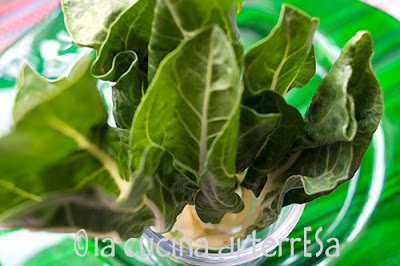EAT SEASONALLY!
MAY :: tomatoes — blette (Swiss chard) w/ erbazzone recipe
TOMAyy-TOES, tomahhh-toes... the ones pictured above appeared mid-April at a favorite marketplace vendor at the Aligre marché. All the way from Sicily... and still green, and still few and far between. (The red ones were as green when I bought them as the shier green one hiding
behind until they ripened into their robust crimson robe.) I
have to tell you that when I bite into my first tomato of the season, a
clamorous joy invades me... They are no longer few and far between, as local producer Eric Martinet — whose produce stand I frequent Wed and Sat at the Cours de Vincennes marché | Thur and Sun at the Bastille marché — has begun to harvest his Campari tomatoes (photo below). One very sweet, juicy, meaty, deep red tomato, sized somewhere between a cherry and plum tomato. Once they hit the marketplaces, I eat mounds and mounds of any and all tomatoes until there
are no more to pluck from the vine, knowing I'll have to go without
their enthusiastic presence and vigor through the long winter months.
But from May to October it's tomato time!
Young bunches of BLETTE leaves are out and about this spring. The blette plant is kin to the
Chenopodiaceae (or Goosefoot) family along with beets, spinach,
amaranth, quinoa, Cultivated around the Mediterranean as
far back as Babylon and ancient Rome, it became popular in France in the
Middle Ages, with many a recipe honoring it. Depending on the variety,
its taste and texture recall that of Swiss chard or collards. That pictured here is an early French variety, available April to mid-May, whose leaves are small and of Collard sturdiness. The variety praised by Italians, whose leaves can achieve
elephantine proportions, has a surprisingly silky texture and thin,
supple leaves. It brings more to mind Swiss chard but for a less steely tang. If growing it in you garden, it can be harvested from July to October.
The larger leafy blette has white ribs which can comprise up to a third
even a half of its size and are rarely discarded. In fact they're
quite prized and spun into succulent gratins and savory tarts in France
and Italy alike. One of my favorite ways to use the colossal leaves is
in the savory erbazzone tart that hails from Emilia-Romagna. The recipe is below...
ERBAZZONE TART - serves 6 - 8
adapted from Les Tables d’Italie d’Aoste à Palerme, éditions Culinaria
dough :
250 gr / 9 oz unbleached white flour (if available, French type 80)
2 tBsp extra-virgin olive oil
150 ml cold water
1/2 tsp unprocessed sea salt
filling :
1 kg / 2 lbs Swiss chard leaves, or a mixture of green Swiss chard, spinach, Russian or Tuscan kale (ribs removed) … In spring you can add dandelion or mustard greens, fresh beet or turnip tops, arugula …
Four-finger pinch flat parsley, coarsely chopped
Three-finger pinch fresh mint, coarsely chopped
4 tBsp extra-virgin olive oil
1 clove garlic, peeled, the sprout removed, and coarsely chopped
50 gr / 1.75 oz grated Parmigiano-Reggiano
Three-finger pinch organic lemon zest
Unrefined sea salt to taste
2 tBsp extra-virgin olive oil to brush pie crust
||| for the dough
Combine the flour, sea salt and olive oil in a bowl. Stir in the water. Pour out onto a floured surface and knead for 10 minutes until dough is smooth and elastic, or in a mixer with a dough hook on low speed for 3-5 min. Wrap in a kitchen towel , cover with the bowl, and set aside to rest for 2 hours.
||| for the filling
Wash the greens, do not dry them, and place them in a large skillet. Cover and cook over medium heat until just wilted, about 5 minutes. Add a tablespoon or two of water if needed. You may need to gradually add the greens and as they wilt add more. Remove from the skillet, drain. When cool enough squeeze out any excess water. Chop finely or rapidly purée in a food processor. Heat the olive oil in the same skillet, rinsed out if need be, and sauté the garlic for 1 min. Add the greens and cook over medium heat for 2-3 minutes. Add the parsley and cook for another 3-4 minutes. Remove from the heat, stir in lemon zest, Parmigiano-Reggiano, and salt and set aside
||| Preheat the oven to 200 ˚C (400 ˚F).
Roll out 2/3 of dough on a floured workspace until quite thin (slight 1/8 inch) Oil the bottom of a 30-cm / 12-inch pie or baking dish with some of the melted butter. Line with the dough. Spread the filling over the pie dough. Roll out remaining the dough and carefully lay it over the filling. Seal the edges and cut vent holes or generously prick with a fork. Brush with the remaining olive oil. Cook on the midle rack for 30-45 minutes, until top is golden brown. Serve hot or at room temperature.





No comments:
Post a Comment